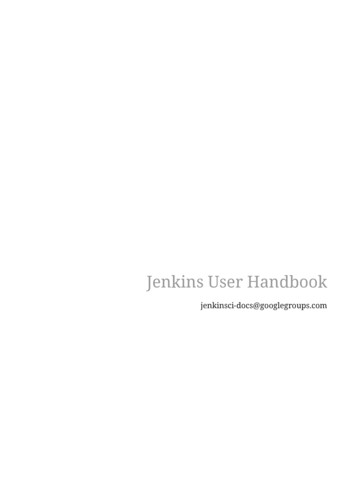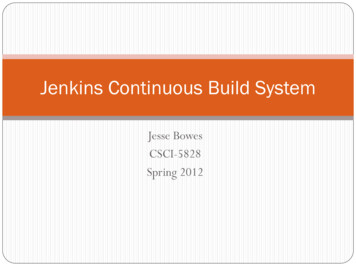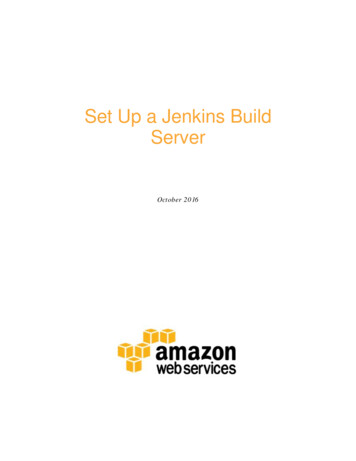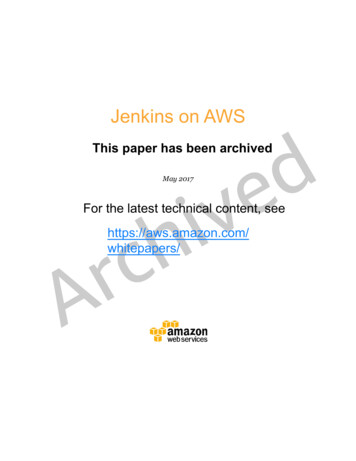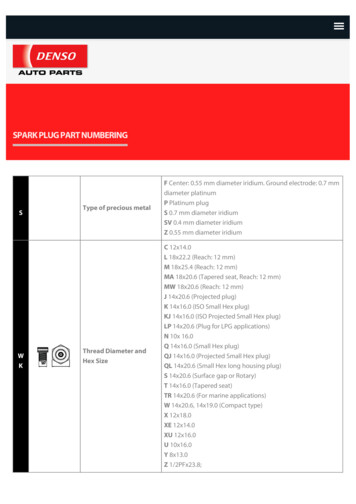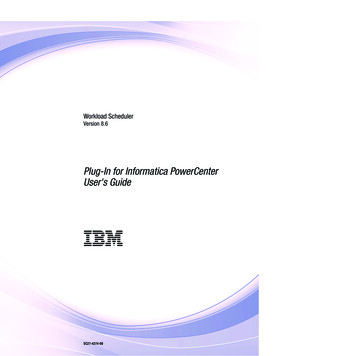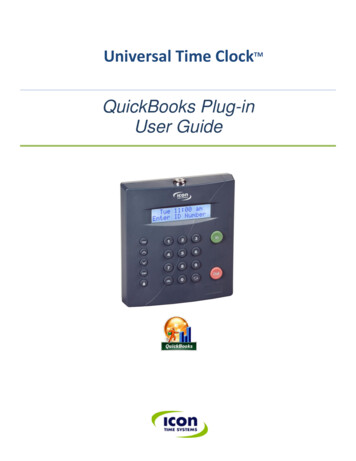
Transcription
Jenkins TestLink Plug-in TutorialBruno P. KinoshitaCésar Fernandes de Almeida
Jenkins TestLink Plug-in TutorialBruno P. KinoshitaCésar Fernandes de AlmeidaFrench Translation.: Flóreal Toumikian, Olivier RenaultReview and suggestions on how explain some topics of this tutorial.: Oliver MerkelAbstractThe Jenkins TestLink Plug-in Tutorial is intended to provide a better understanding on how to use the plug-in to integrateJenkins and TestLink. It is an Open Source project, so contributions and suggestions are welcome.
Jenkins TestLink Plug-in TutorialTable of Contents1.2.3.4.An Introduction to Jenkins . 1An Introduction to TestLink . 3Jenkins and TestLink Integration . 5TestLink Configuration . 64.1. Installing TestLink . 64.2. Creating a Test Project . 94.3. Creating and assigning a Custom Field . 114.4. Specifying Test Suite and Test Cases . 134.5. Create a Test Plan and add the Test Cases . 165. Jenkins Configuration . 205.1. Installing Jenkins . 205.2. Installing and configuring Jenkins TestLink Plug-in . 205.3. Creating a job in Jenkins . 225.4. Explaining the Job configuration parameters . 25TestLink Version . 26Test Project Name . 26Test Plan name . 26Build Name . 26Custom fields . 26Key Custom Field . 26Single Build Steps . 26Before iterating all test cases Build Steps . 26Iterative Test Build Steps . 26After iterating all test cases Build Steps . 26JUnit, TestNG and TAP report files patterns. . 26Transactional execution? . 27Failed tests mark build as failure . 27Environment variables . 276. Executing Automated Test Cases . 287. Strategies to find Test Results . 327.1. JUnit . 327.2. TestNG . 327.3. TAP - Test Anything Protocol . 338. Advantages of using Jenkins TestLink Plug-in . 349. Appendix . 359.1. Adding attachments to your test results . 359.2. Using Platforms . 359.3. Plug-in behavior in distributed environments . 369.4. How to use the plug-in with SSL or basic authentication? . 36Bibliography . 37Jenkins TestLink Plug-in Tutorialiii
Jenkins TestLink Plug-in Tutorial1. An Introduction to JenkinsJenkins (née Hudson) is a continuous integration server written in Java. It can be downloaded from http://www.jenkins-ci.org [http://www.jenkins-ci.org] as an executable war. It means that you can run it with java jar jenkins.war. Jenkins comes with an embedded Servlet Container (Winstone) but you also have the optionto deploy the war to an application server like Tomcat, Jetty, JBoss, etc. Jenkins does not use any database tostore its configuration. Jenkins uses XStream to save data as XML files.With Jenkins you can create, monitor and schedule jobs. There are plug-ins for almost anything that you maythink about, from different SCMs (git, mercury, SVN, CVS) to plug-ins for integrating your Jenkins withSelenium, Gerrit, TestLink and other tools.Here is a summarized list of Jenkins features that is available in Jenkins Wiki nk Plugin]:1. Easy installation2. Easy configuration3. Change set support4. Permanent links5. RSS/E-mail/IM Integration6. After-the-fact-tagging7. JUnit/TestNG test reporting8. Distributed builds9. File fingerprinting10.Plugin SupportFor this guide you will need to download the latest and greatest version of Jenkins. At the moment that thisguide is being written, the current version is 1.433. However it is very likely that what you will learn here willwork with newer versions of Jenkins. Jenkins development team does a great job not only developing coolfeatures, but also keeping backward compatibility between versions.Jenkins TestLink Plug-in Tutorial1
Jenkins TestLink Plug-in TutorialJenkins is licensed under the MIT License and its code is hosted at GitHub - http://github.com/jenkinsci [http://github.com/jenkinsci].Jenkins TestLink Plug-in Tutorial2
Jenkins TestLink Plug-in Tutorial2. An Introduction to TestLinkTestLink is an open source test management tool written in PHP. In order to install TestLink you will needa HTTP server with PHP 5 and a database. The databases currently supported by TestLink out of the boxare MySQL, Postgre SQL and MS SQL, although there are users that managed to use Oracle too. You candownload it from http://www.teamst.org [http://www.teamst.org].In TestLink you have, among other features, Test Plans, Requirement management, Baselines, Custom Fields,Test Suite with Test Cases and Reporting. For external access, there is an XML-RPC API available (it is notenabled by default). Other two nice features in TestLink are the versioning of the some entities, like Test Caseand Requirements, and the ability to import and export data in different formats.There are bindings for the TestLink XML-RPC API available for Java, Perl, PHP, Ruby and other programminglanguages. The integration between Jenkins and TestLink is done using TestLink Java API - http://testlinkjavaapi.sourceforge.net [http://testlinkjavaapi.sourceforge.net].At the moment that this guide is being written the latest version of TestLink is 1.9.3. While the Jenkins versionis not a big issue for this integration, the same cannot be said about TestLink. This guide is intended forTestlink 1.9.3 XML-RPC API. In case there are other versions available at the moment that you are readingJenkins TestLink Plug-in Tutorial3
Jenkins TestLink Plug-in Tutorialthis guide, please consult the plug-in Wiki nk Plugin] forfurther information on this.TestLink is licensed under the GPL License and its code is hosted at gitorious - http://www.gitorious.org/testlink-ga/testlink-code e].Jenkins TestLink Plug-in Tutorial4
Jenkins TestLink Plug-in Tutorial3. Jenkins and TestLink IntegrationThe integration between Jenkins and TestLink can be achieved with Jenkins TestLink Plug-in. The plug-inresides in Jenkins, being able to use some of its nice features like executing multiple jobs, scheduling jobs,distributed execution and a plethora of plug-ins. To retrieve the data from TestLink for tests, as well as to reportthe test case execution status to TestLink, the plug-in uses TestLink XML-RPC API.This way, while Jenkins handles the execution of jobs and tasks such as downloading source code from anSCM, TestLink maintains the structure of your tests, as well as other assets as Test Plan, Custom Fields, Reportsand Baselines.We will see how to configure our envinronment for this integration throughout the next chapters. While it isgood to have a good written explanation on how this integration works, probably it is a lot easier to understandhow it works with a hands-on. The rest of this guide explains how to configure Jenkins and TestLink to runautomated tests from a sample test project. This test project is a Java project that uses Maven and TestNGand you can download the source code from utorial tutorial] (as well as the DocBook source for this book).The current version of Jenkins TestLink Plug-in while this book is being written is 3.0.2.Jenkins TestLink Plug-in is licensed under the MIT License and its code is stored in github - http://github.com/jenkinsci/testlink-plugin ins TestLink Plug-in Tutorial5
Jenkins TestLink Plug-in Tutorial4. TestLink Configuration4.1 Installing TestLinkIn this part of the tutorial we will show how to install and configure TestLink. Let's start by downloadingtestlink-1.9.3.tar.gz from http://www.teamst.org. Decompress it with tar -zxvf testlink-1.9.3.tar.gz. Move thedirectory created to your HTTP server root directory and open http://localhost/testlink-1.9.3 [http://localhost/testlink-1.9.3] in your browser.Jenkins TestLink Plug-in Tutorial6
Jenkins TestLink Plug-in TutorialNow the installation wizard will guide you through the rest of the installation. But before going on, we needto create a database in MySQL.mysql create database testlink;The next step is to create a user that TestLink will use to access the database.mysql grant all privileges on testlink.* to 'testlink' identified by 'testlink';mysql flush privileges;Jenkins TestLink Plug-in Tutorial7
Jenkins TestLink Plug-in TutorialJenkins TestLink Plug-in Tutorial8
Jenkins TestLink Plug-in TutorialIf everything worked out correctly you should be asked to log in with user admin and password admin. Theexamples in this tutorial require you to have a user with administrator rights in TestLink.By default, the XML-RPC comes disabled in TestLink. Let's enable it by editing config.inc.php, located inTestLink root folder. tlCfg- api- enabled TRUE;Finally, let's make sure that the attachments retrieved from the database are ordered by its ID. This way, theorder of attachments will be preserved in TestLink. We could use the date that the attachment was inserted indatabase, however the precision of the date added column is in seconds, what could lead to inconsistencies inthe way that attachments are displayed in TestLink. g attachments- order by " ORDER BY id ASC ";4.2 Creating a Test ProjectWhen you log in by the first time in TestLink it is showed to you a form to create a Test Project. After creatinga test project you will be able to create test plans, requirements, specify and execute your tests.Jenkins TestLink Plug-in Tutorial9
Jenkins TestLink Plug-in TutorialCreate a test project with name My first project, prefix MFP and make sure the following options are checked:Enable Requirements feature, Enable Testing Priority, Enable Test Automation (API keys), Enable Inventory,Active and Public. Click on Create button.Jenkins TestLink Plug-in Tutorial10
Jenkins TestLink Plug-in TutorialIf the following screen is not displayed, review your previous steps or consult TestLink documentation forfurther assistance.4.3 Creating and assigning a Custom FieldClick on the Project item of the top menu to be redirected to the main screen.
Jenkins TestLink Plug-in Tutorial Jenkins TestLink Plug-in Tutorial 13 4.4 Specifying Test Suite and Test Cases For those who work with tests this part may be slightly easier than the previous sections. What we are going to do now is to create a test suite and some test cases. In TestLink your test cases are kept under a test suite which is, by its turn, under a test project. Back to the main .File Size: 2MBPage Count: 40
